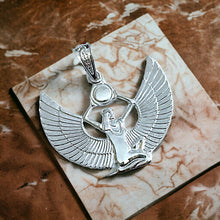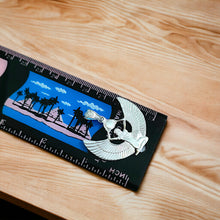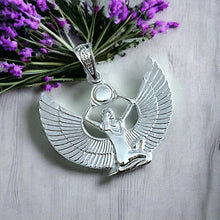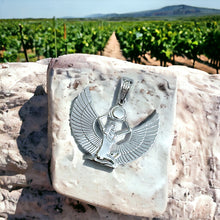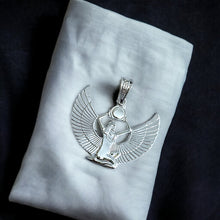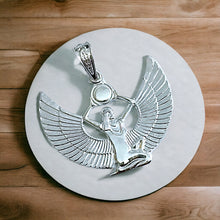
The Silver Goddess Isis Pendant Necklace is inspired by the ancient Egyptian goddess Isis, symbolizing femininity, magic, and protection. It pays homage to the rich history and mythology of ancient Egypt, where Isis was revered as a powerful deity associated with love, motherhood, and healing.
- History: Inspired by ancient Egyptian mythology, honoring the goddess Isis, symbolizing magic, healing, and motherhood.
- Spirituality: Represents divine femininity, protection, and empowerment, drawing from the goddess's legendary attributes.
- Talisman: Considered a potent charm for spiritual guidance, strength, and manifestation of intentions.
- Handmade: Crafted with meticulous care, each pendant holds unique artisanal qualities, fostering a personal connection.
- Healing: Associated with emotional healing, inner strength, and transformation, resonating with the wearer's journey.
- Material: Fashioned from sterling silver, embodying purity, clarity, and enduring quality.
- Symbolism: Intricately designed to reflect sacred symbols of Isis, invoking blessings and spiritual alignment.
- How to Wear: Designed to fit any chain up to 5mm, offering versatility in styling and personal expression.
History Side For Those Who Are Interested
Isis, a prominent figure in ancient Egyptian mythology, was worshipped as a powerful goddess associated with fertility, motherhood, magic, and protection. Her origins can be traced back to the earliest periods of Egyptian civilization, and her cult gained widespread popularity throughout the ancient Mediterranean world.
The name "Isis" is derived from the Egyptian word "Aset," which means "throne" or "queen of the throne," reflecting her importance as a divine queen and mother figure. She was often depicted wearing a throne-shaped headdress or with a sun disk and cow horns, symbolizing her connection to royalty and fertility.
One of the most famous myths surrounding Isis centers on her relationship with her husband Osiris, the god of the afterlife and the underworld. According to legend, Osiris was murdered by his jealous brother Seth, who dismembered his body and scattered the pieces throughout Egypt. Isis, grief-stricken by her husband's death, searched tirelessly for his body, eventually finding and reassembling it. Through her magical powers, she was able to revive Osiris long enough to conceive their son, Horus.
Isis was revered as a compassionate and nurturing goddess, often depicted cradling her infant son Horus or assisting the dead on their journey to the afterlife. Her role as a protective deity extended to all aspects of life, and she was invoked by individuals seeking guidance, healing, and protection.
As Egyptian religion evolved over time, Isis's cult continued to flourish, eventually spreading beyond Egypt's borders to encompass other regions of the ancient world. During the Hellenistic and Roman periods, her worship became increasingly syncretic, merging with the cults of other goddesses such as Demeter, Aphrodite, and Artemis.
The influence of Isis persisted into the Christian era, with some aspects of her imagery and symbolism being absorbed into the cult of the Virgin Mary. Despite the decline of ancient Egyptian religion, Isis remained a powerful and enduring figure in the collective imagination, inspiring devotion and reverence for millennia.







